|
|
Published May 26th, 2021
|
Digging Deep with Goddess Gardener, Cynthia Brian
|
| Wildfire protection through landscaping |
| By Cynthia Brian |
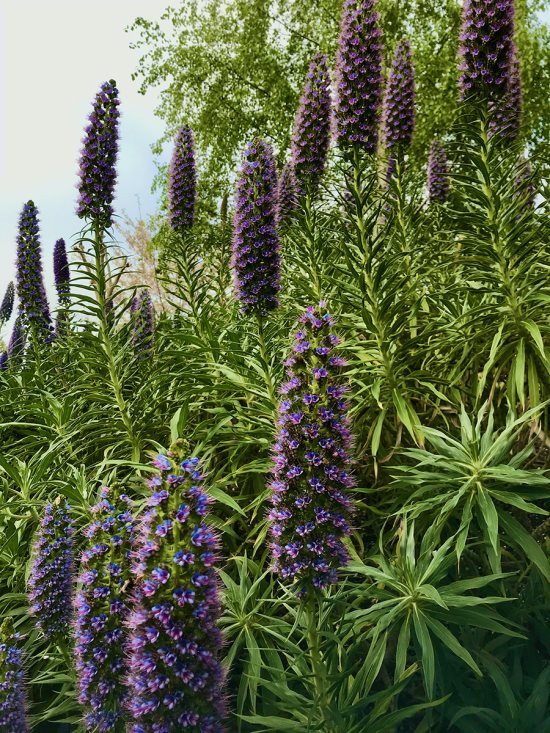 |
| Drought-resistant Pride of Madeira grows well on hillsides but is considered flammable. Photo Cynthia Brian |

 "Fire is never a gentle master."~ Proverb
"Fire is never a gentle master."~ Proverb
 This past year most of our conversations have revolved around the pandemic, mask wearing, and questions about recovery and normalcy. With the impending drought, an urgent topic that is on the minds of Californians is the potential for wildfires. With increasing climate changes and the trend of global warming, it is not a matter of if we'll be faced with fires, it is when.
This past year most of our conversations have revolved around the pandemic, mask wearing, and questions about recovery and normalcy. With the impending drought, an urgent topic that is on the minds of Californians is the potential for wildfires. With increasing climate changes and the trend of global warming, it is not a matter of if we'll be faced with fires, it is when.
 We can do our part to protect our property as best as possible through firescaping, a landscape design that reduces house and property vulnerability to wildfire. While enhancing the beauty of the property and creating a defensible space, we surround the house with plants that are less likely to ignite. Fires respect no boundaries and fires don't honor property lines. With enough heat, almost everything burns.
We can do our part to protect our property as best as possible through firescaping, a landscape design that reduces house and property vulnerability to wildfire. While enhancing the beauty of the property and creating a defensible space, we surround the house with plants that are less likely to ignite. Fires respect no boundaries and fires don't honor property lines. With enough heat, almost everything burns.
 Our neck of the woods is rural and wooded. We have minimal escape routes and must be extra vigilant. Many of the plants and trees growing throughout our area are highly flammable including pines, cypress, cedar, fir, bamboo, acacia, juniper, Pampas grass, rosemary, ivy, arborvitae, miscanthus, and eucalyptus. Coyote brush, although moderately fire-resistant when it is young and green, is highly combustible as it grows. It depends on fires to regenerate and grows everywhere in our hills. These plants need to be removed or carefully supervised. Since heat moves up, fire speed and severity are stronger on slopes where vegetation management is crucial.
Our neck of the woods is rural and wooded. We have minimal escape routes and must be extra vigilant. Many of the plants and trees growing throughout our area are highly flammable including pines, cypress, cedar, fir, bamboo, acacia, juniper, Pampas grass, rosemary, ivy, arborvitae, miscanthus, and eucalyptus. Coyote brush, although moderately fire-resistant when it is young and green, is highly combustible as it grows. It depends on fires to regenerate and grows everywhere in our hills. These plants need to be removed or carefully supervised. Since heat moves up, fire speed and severity are stronger on slopes where vegetation management is crucial.
 A defensible space is an area around a structure that has been cleared of ignitable debris and botanicals that may cause a public safety hazard. A watered, green lawn can be considered a defensible space. A large brick, stone, or gravel area could be part of a defensible space.
A defensible space is an area around a structure that has been cleared of ignitable debris and botanicals that may cause a public safety hazard. A watered, green lawn can be considered a defensible space. A large brick, stone, or gravel area could be part of a defensible space.
 No plant is fireproof.
No plant is fireproof.
 Under the right conditions, every plant will burn, especially those that are drought-stressed or not maintained. Pruning of all plants makes them less flammable. A "fire-safe" plant means that it tends not to be a significant fuel source with a chemical composition that resists heat and combustion. It is critical to keep plants around our homes well-tended and pruned as a fire protection tool. The closer plants are to the house, the more care is needed.
Under the right conditions, every plant will burn, especially those that are drought-stressed or not maintained. Pruning of all plants makes them less flammable. A "fire-safe" plant means that it tends not to be a significant fuel source with a chemical composition that resists heat and combustion. It is critical to keep plants around our homes well-tended and pruned as a fire protection tool. The closer plants are to the house, the more care is needed.
 Every homeowner is responsible for managing their vegetation to meet fire district requirements. For Moraga-Orinda Fire District requirements, combustible materials must be two feet away from a structure and plantings no taller than two feet high. Low-growing ground coverings and green grass are suitable as well as river rock, gravel, or crushed granite. Trees that are within six feet of the structure need to be removed, specifically eucalyptus, pine, bamboo, and junipers.
Every homeowner is responsible for managing their vegetation to meet fire district requirements. For Moraga-Orinda Fire District requirements, combustible materials must be two feet away from a structure and plantings no taller than two feet high. Low-growing ground coverings and green grass are suitable as well as river rock, gravel, or crushed granite. Trees that are within six feet of the structure need to be removed, specifically eucalyptus, pine, bamboo, and junipers.
 Neighborhoods are encouraged to form a committee to receive advice from local fire professionals on how to be Firewise. Being Firewise is dependent on the diligence of everyone in a neighborhood to keep a property fire safe. All properties become indefensible when one neighbor has overgrown bushes, brush, or low hanging trees. Neighbors must protect neighbors by making certain their properties are maintained. Again, fires do not honor property lines.
Neighborhoods are encouraged to form a committee to receive advice from local fire professionals on how to be Firewise. Being Firewise is dependent on the diligence of everyone in a neighborhood to keep a property fire safe. All properties become indefensible when one neighbor has overgrown bushes, brush, or low hanging trees. Neighbors must protect neighbors by making certain their properties are maintained. Again, fires do not honor property lines.
 Characteristics of highly flammable flora
Characteristics of highly flammable flora
 o Dry and dead leaves, twigs, branches
o Dry and dead leaves, twigs, branches
 o Abundant, dense foliage
o Abundant, dense foliage
 o Needles
o Needles
 o Low moisture foliage
o Low moisture foliage
 o Peeling, loose bark
o Peeling, loose bark
 o Gummy sap
o Gummy sap
 o Leathery, dry, or aromatic leaves
o Leathery, dry, or aromatic leaves
 o Content of terpene, oils, or resin
o Content of terpene, oils, or resin
 o Dry uncut grasses
o Dry uncut grasses
 Characteristics of reasonably fire-resistant plants?
Characteristics of reasonably fire-resistant plants?
 o Hardy, slow-growing plants that don't produce litter or thatch.
o Hardy, slow-growing plants that don't produce litter or thatch.
 o Drought tolerant natives with internal high-water content.
o Drought tolerant natives with internal high-water content.
 Generally, but not always, California natives are more tolerant of fire and deer.
Generally, but not always, California natives are more tolerant of fire and deer.
 o Trees with thick bark that restrict the growth of invasive shrub species and hardwood trees such as walnut, cherry, maple, and poplar are less flammable. Deciduous trees and shrubs are more fire-resistant because they have higher moisture content when in leaf, lower fuel volume when dormant, and usually do not contain flammable oils.
o Trees with thick bark that restrict the growth of invasive shrub species and hardwood trees such as walnut, cherry, maple, and poplar are less flammable. Deciduous trees and shrubs are more fire-resistant because they have higher moisture content when in leaf, lower fuel volume when dormant, and usually do not contain flammable oils.
 o Supple, moist leaves with little to no sap or resin residue.
o Supple, moist leaves with little to no sap or resin residue.
 o Low growing ground covers.
o Low growing ground covers.
 o Bulbs with dried leaves cut to the ground.
o Bulbs with dried leaves cut to the ground.
 What can you do now to create a more fire-resistant landscape?
What can you do now to create a more fire-resistant landscape?
 o Include pavers, bricks, pavement, gravel, rocks, dry creek beds, fountains, ponds, pools, and lawns.
o Include pavers, bricks, pavement, gravel, rocks, dry creek beds, fountains, ponds, pools, and lawns.
 o Select high moisture plants that grow close to the ground with a low sap and resin content.
o Select high moisture plants that grow close to the ground with a low sap and resin content.
 o Plant the right plant in the correct location. Leave space between plants.
o Plant the right plant in the correct location. Leave space between plants.
 o Minimize the inclusion of evergreen trees within 30 feet of structures. Clear the understory. Keep trees 20 feet away from chimneys.
o Minimize the inclusion of evergreen trees within 30 feet of structures. Clear the understory. Keep trees 20 feet away from chimneys.
 o Remove invasive species or swaths of flammable plants including ivy, rosemary, broom, coyote brush, chamise and juniper.
o Remove invasive species or swaths of flammable plants including ivy, rosemary, broom, coyote brush, chamise and juniper.
 o Keep mulch moist. Create zones of rock, brick or gravel. Bark and leaves are not mulches recommended near structures.
o Keep mulch moist. Create zones of rock, brick or gravel. Bark and leaves are not mulches recommended near structures.
 o Prune trees 6-10 feet above the ground to hinder fire laddering.
o Prune trees 6-10 feet above the ground to hinder fire laddering.
 o Keep appropriate clearance to reduce the threat of burning embers from decorative features such as gazebos, fences, sheds, porches and junk areas.
o Keep appropriate clearance to reduce the threat of burning embers from decorative features such as gazebos, fences, sheds, porches and junk areas.
 o Irrigate and maintain all flora, lawns and hillsides. Clover, groundcovers, and grasses that are kept low and green are excellent alternatives.
o Irrigate and maintain all flora, lawns and hillsides. Clover, groundcovers, and grasses that are kept low and green are excellent alternatives.
 o Due to soil erosion, bare ground is not recommended.
o Due to soil erosion, bare ground is not recommended.
 Prone to Ignite Plants
Prone to Ignite Plants
 If you have these specimens in your garden, prune and maintain appropriately or eliminate them.
If you have these specimens in your garden, prune and maintain appropriately or eliminate them.
 General Rules of Fire Safety
General Rules of Fire Safety
 Heed the checklist from our local fire departments to create a defensible space around your home. Follow fire district recommendations:
Heed the checklist from our local fire departments to create a defensible space around your home. Follow fire district recommendations:
 o Prevent embers from igniting your home by clearing leaves, needles, and debris from gutters, eaves, porches and decks.
o Prevent embers from igniting your home by clearing leaves, needles, and debris from gutters, eaves, porches and decks.
 o Mow grasses and weeds.
o Mow grasses and weeds.
 o Keep your garden watered.
o Keep your garden watered.
 o Prune tree limbs to keep the lowest branches 6-10 feet from the ground.
o Prune tree limbs to keep the lowest branches 6-10 feet from the ground.
 o Reduce "fire fuel laddering" by not allowing bushes or trees to touch one another.
o Reduce "fire fuel laddering" by not allowing bushes or trees to touch one another.
 o Keep combustible materials 15-30 feet away from structures.
o Keep combustible materials 15-30 feet away from structures.
 o Maintain your property and be alert for any fire danger.
o Maintain your property and be alert for any fire danger.
 Weed abatement must be completed by June 1. Get out there and get your landscape more fire-resistant. We all have a responsibility to one another to help keep our community from experiencing a wildfire.
Weed abatement must be completed by June 1. Get out there and get your landscape more fire-resistant. We all have a responsibility to one another to help keep our community from experiencing a wildfire.
 Happy Gardening. Happy Growing. Be fire safe.
Happy Gardening. Happy Growing. Be fire safe. |
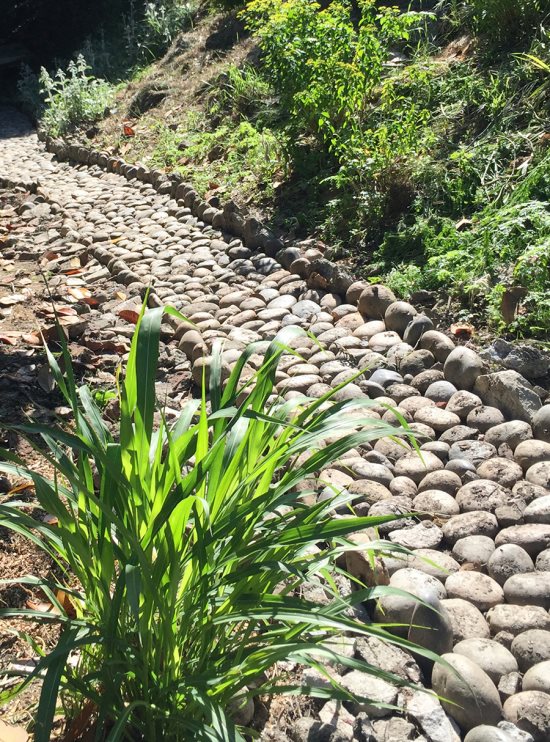 |
| A river rock canal provides some protection near structures. Photo Cynthia Brian |
 |
| Add gravel near a wooden porch to reduce flammability. Photo Cynthia Brian |
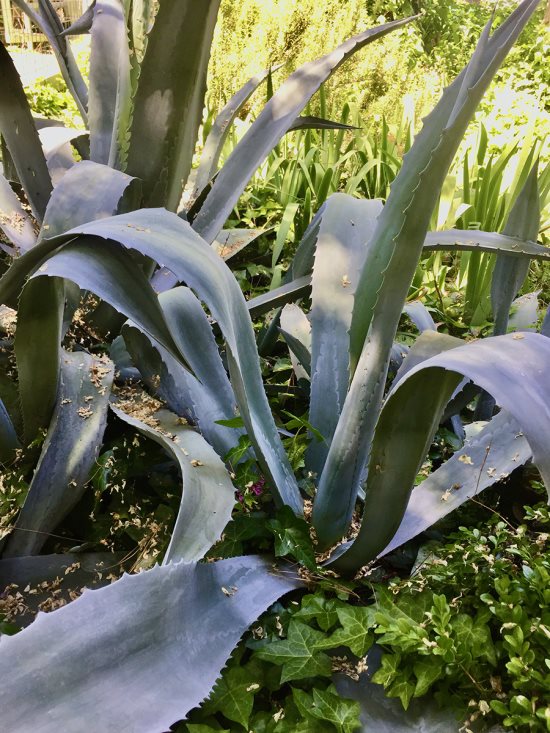 |
| Agave is drought tolerant. All parts are toxic, except the flowers. Photo Cynthia Brian |
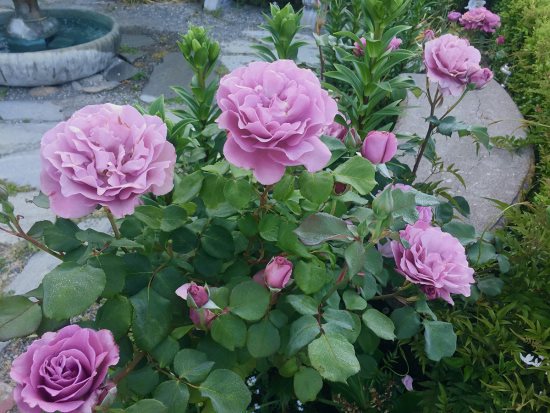 |
| Angel Face Roses surrounded by flagstone and gravel for fire-resistance. Photo Cynthia Brian |
 |
| Strawberries planted as a low ground
cover would reduce ignition. |
| |
| |
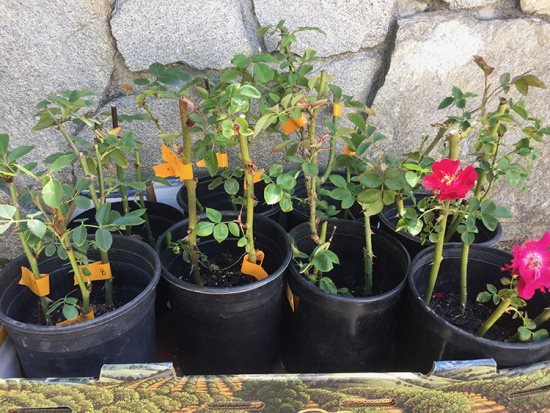 |
| Rose cuttings from February are now
sprouting and ready to be planted. |
 |
| Cynthia Brian in the spring garden
with yellow freesias and blue woodland hyacinths. |
| Cynthia
Brian, The Goddess Gardener, is available for hire to help you prepare
for your spring garden. Raised in the vineyards of Napa County,
Cynthia is a New York Times best-selling author, actor, radio
personality, speaker, media and writing coach as well as the Founder
and Executive Director of Be the Star You Are!r 501 c3. Tune into
Cynthia's StarStyler Radio Broadcast at
www.StarStyleRadio.com.
Buy copies of her best-selling books, including, Chicken Soup for the
Gardener's Soul, Growing with the Goddess Gardener, and Be the Star
You Are! Millennials to Boomers at
www.cynthiabrian.com/online-store. Receive a FREE inspirational
music DVD. Hire Cynthia for writing projects, garden consults, and
inspirational lectures.
Cynthia@GoddessGardener.com
www.GoddessGardener.com |
|
|
|












